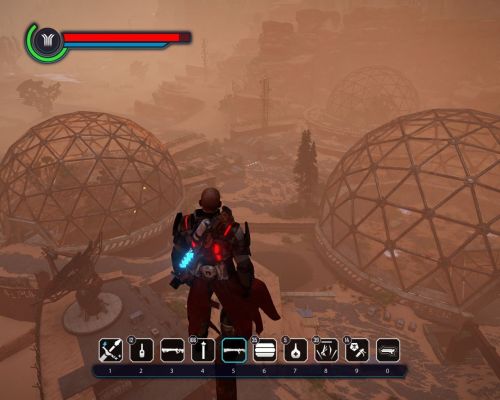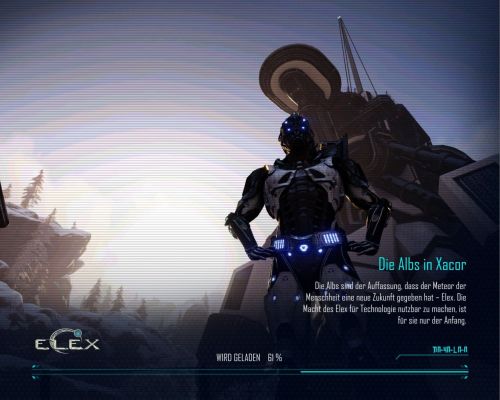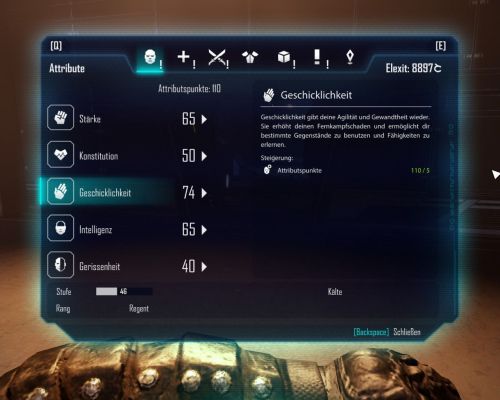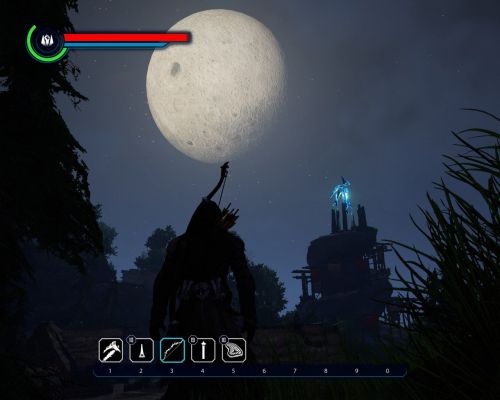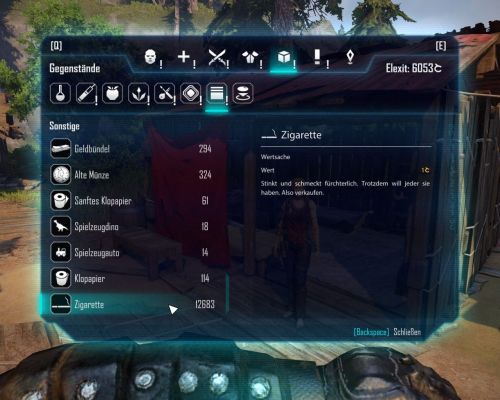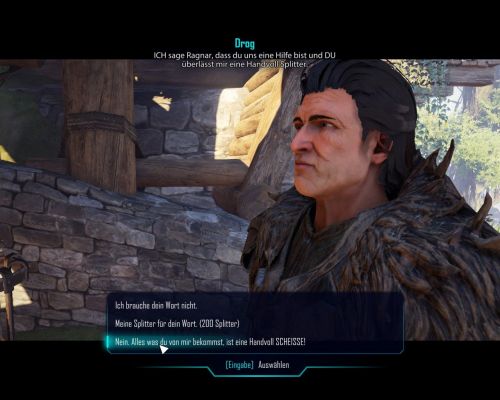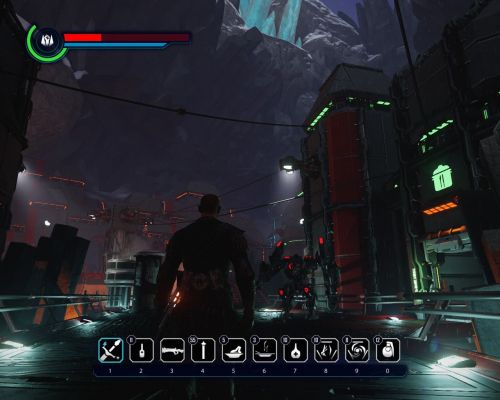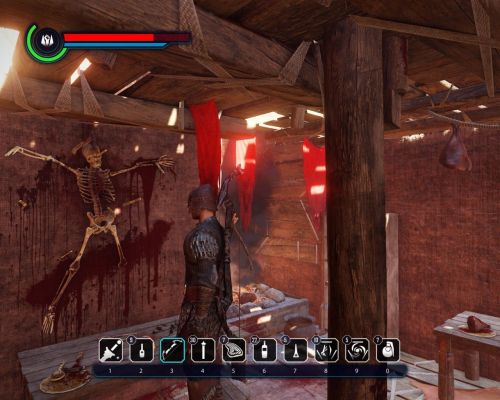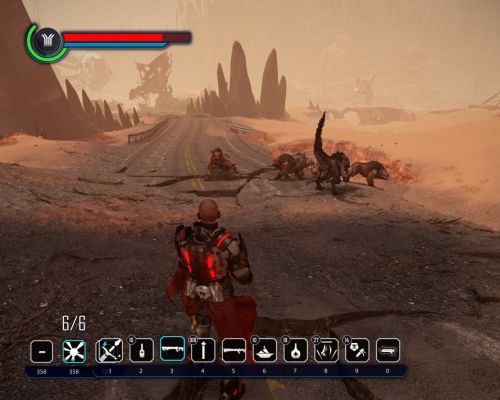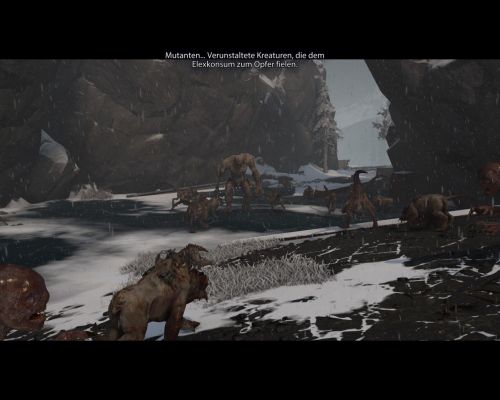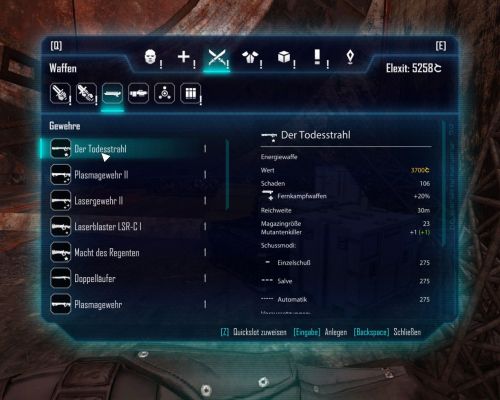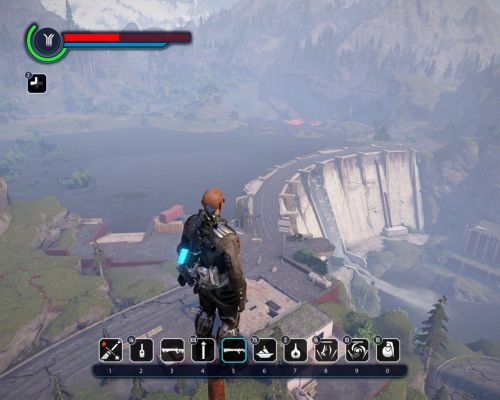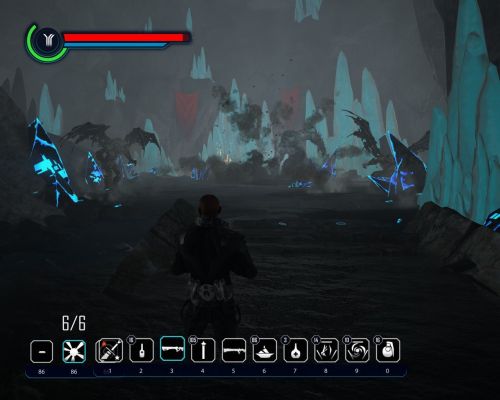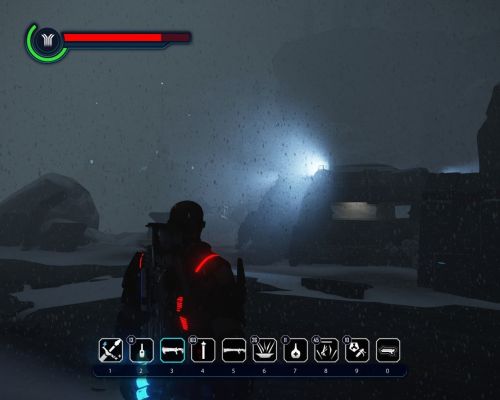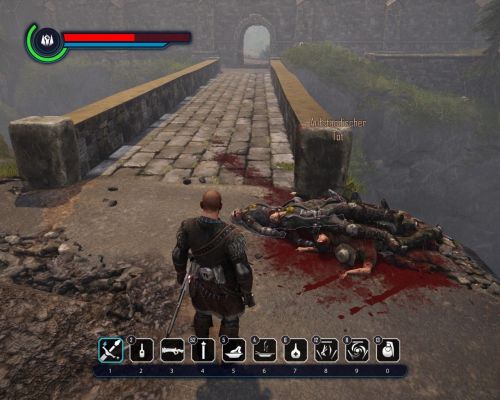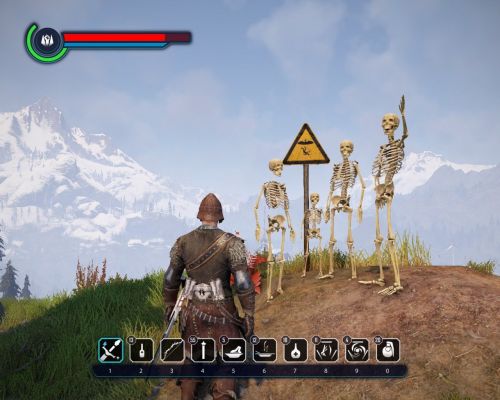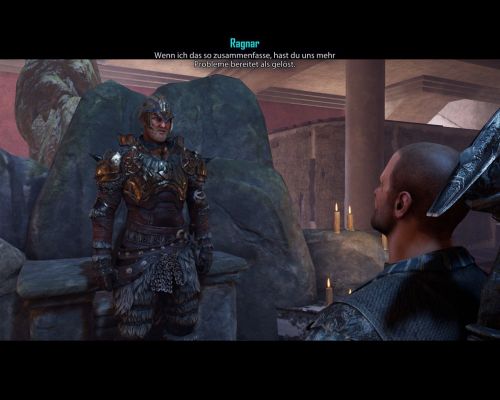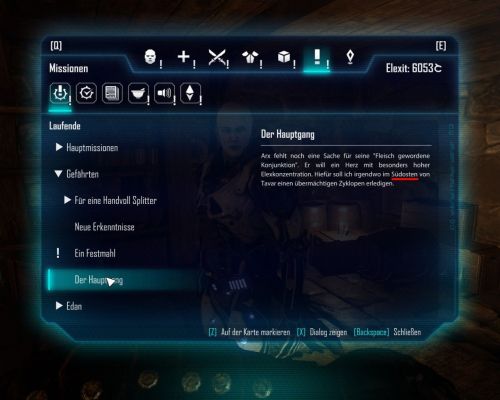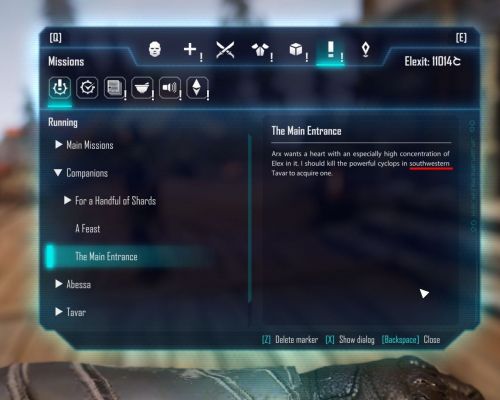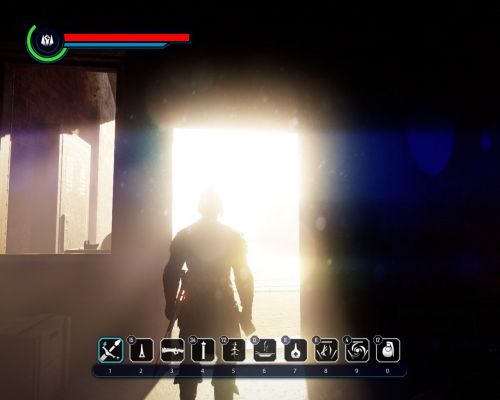RPG Codex Review: ELEX!
RPG Codex Review: ELEX!
Codex Review - posted by Infinitron on Sat 9 December 2017, 23:55:39
Tags: ELEX; Piranha Bytes[Review by Darth Roxor]
Eclectic
Five long years have passed since Piranha Bytes had a collective bout of dementia and released the nightmare known as Risen 2. The release of Risen 3 two years later showed that the German developers were evidently rejecting their medication because the game turned out to be even worse than its prequel.
With such disasters under their belt, it would take only the greatest of madmen to await the release of their next game: ELEX. Especially since, to make matters even worse, ELEX just looked kind of stupid in the pre-release materials, like some crazy 80s action cartoon universe mashup, but still not corny enough for the style to seem as fun as that of the Wizardry or Might and Magic series.
Though you know what they say. Only the insane shall prosper.
Disclaimer: Since I played the only true version of ELEX, all screenshots are in German and some of the names I toss around might not be exactly the way they’re found in game. But since rpgcodex.de is an inclusive multicultural environment, I figured there’d be no harm done.
Lavish
Starting the game gives us a brief introduction into Magalan – the planet on which ELEX takes place. Some time ago, the world was struck by a huge meteor that wiped out most of civilisation and brought a powerful, almost magical mineral to its surface – Elex. Elex is a bit like a mix of the spice from Dune and Tiberium from Command and Conquer. It is unstable, can cause organisms to mutate, can power up machines and give humans extraordinary abilities, but at a price – consuming Elex suppresses emotions and turns people into near-automatons that live by logic only.
The factions of Magalan all have different attitudes towards Elex, ranging from shunning it to basing their entire lives on its consumption. The latter folk are called the Albs, and they are the setting’s Big Bad Guys. Interestingly enough, our very own protagonist is, in fact, an Alb. Even more interesting, for the first time in the history of PB games, he has a name – Jax!
The intro ends with Jax entering his fancy glider and flying off on some sort of secret mission. Then an in-game cutscene triggers, and things start getting a bit wonky. It’s not exactly easy to say what happens next, except that Jax is shot out of the sky by someone, then his Alb buddies arrive in the nick of time to execute him for no apparent reason, and finally he gets robbed by some bloke after falling down a ledge. All this leaves Jax a broken shell of a man – his gear is gone and his stats are all conveniently reduced to zero because he’s starting to suffer from “Elex withdrawal”. It’ll be our job to bring him back to the top of the food chain.
At first glance, the character system looks fairly complex. You have five attributes – strength, dexterity, constitution, intelligence and cunning – that are supposed to increase various substats, like HP, mana or damage. Then you have a number of skill categories – like combat and survival – that encompass loosely related skills and abilities. Said skills are often tiered (like 3 tiers of increased melee damage), they all add up into “ratings” for the general skill categories and all of them have varying attribute requirements to unlock. There are also three categories exclusive to the in-game factions that you will join later on.
Sadly, all this is much more simple than you might think. The attributes, for starters, don’t do anything by themselves, even if their in-game descriptions might claim otherwise. They only act as unlocks for skills and equipment. The skill category ratings also don’t do anything – these are used only in dialogue skill checks. So the only thing left that really matters are the skills, and in their case, you can also sift out a chunk of less useful ones almost immediately.
Still, this doesn’t mean that character building is meaningless or anything of the sort. This is primarily because your natural attribute and skill gains from level-ups are very limited, so a degree of planning and prioritising, especially in the early game, is crucial to survive (although there’s a huge caveat here, but I’ll return to it later). Each level, you get 10 attribute points and 1 skill point. Attribute points you can assign immediately, though their assignment costs rise along with the attributes themselves. Skills, on the other hand, cost money to raise, have very high attribute requirements at upper tiers and need to be learned at teachers. So in other words, it actually takes a long while to get Jax where you want him to be.
Also speaking of skill teachers, their implementation leaves a lot to be desired. Each teacher has one full skill category assigned to him (like “survival teacher”), and each settlement in the game has a “full set” of them. This means you never have to make an effort to find someone to teach you the most powerful stuff, which is a big blow to exploration, quest design and faction disparity. Not to mention it’s silly when a technology-shunning hippie can teach you the secrets of performing a jetpack slamming attack and improving your grenade throwing skills.
One aspect of the character system that I find well realised is how it encourages “multiclassing”. I mean, it seems obvious considering that in all PB games you end up as a fighter/mage/thief extraordinaire, but what ELEX does well is link multiple playstyles through the system itself by making almost all weapons and skills have double attribute requirements. For example, the following things require you to raise both STR and DEX to use: swords (one and two handed), bows and the melee damage boost skill. STR and CON with a dash of DEX will let you use heavy melee (maces, axes) and ranged (flamers, rocket launchers) weapons. This spreading also works well to remove “dump stats” from the game – the only attribute that, to me, stands as comparably less useful to the others is Cunning, but even that one has a number of handy applications.
Also while on the subject of equipment, crafting in ELEX is nice and unobtrusive, which is a welcome change from most other games nowadays that almost transform it into a minigame of its own. You can find recipes for special food to cook (and some of these dishes outclass healing potions, especially with the “good eater” skill), you can upgrade weapons with additional damage and status effects, brew potions, make stat-raising jewellery, concoct stims that act as buffs, and put gems that provide various enhancements into gear. It’s not perfect, of course, because for example the gems are laughably bad when you consider their rarity, and it’s impossible to tell how some of the weapon status effects actually function, but it’s overall a solid addition. Also, all the garbage you need for crafting is readily available so you don’t have to dive after it into every dumpster.
However, and this is a very big however, what severely hampers planning your character development is the ridiculous opacity of the character sheet itself. None of the skills ever give you any detailed indication as to what they do, except for general descriptions like “inflict more damage with melee weapons”. Worse yet, the game goes out of its way to hide all the statistics from the player, including health – its only representation is a red bar in the main UI, nowhere will you find any sort of numerical value. Even worse, ELEX also throws multiple gameplay terms and concepts at you, but never actually bothers explaining any of them. As an example, consider “attack strength”, which you can increase with your hard-earned skill points. Sounds like a damage boost, doesn’t it? Wrong. What “attack strength” does in practice is shrouded in great mystery, and even after playing the game for over 80 hours I can only speculate as to its purpose.
The effects of this opacity are absurd. They make every advancement feel like a gamble or an R&D project. First you take the plunge and blindly pick a skill, after which you proceed to test what it does by running around naked and whacking monsters with different weapons, until you finally realise your last choice was garbage and reload the game. It has one lovably “oldschool” aspect of trying to find out just how the hell does anything function, but seriously speaking, this has no place in 2017. It would have no place 30 years ago either, because all of this would have been packed inside a manual. A manual, or at least more detailed tooltips and UI, is something that ELEX needs really badly, and I will also come back to this once I discuss its combat.
To continue with the negative parts of the character system, I’d like to return to the caveat I flagged earlier. I said that the system is stingy when it comes to upgrade point gains with each level-up, but that is true only in principle. In classic Piranha Bytes tradition, you can give your character a leg up with stat-increasing potions. In ELEX, those are Elex potions that come in three varieties – minor (XP boost), medium (attribute points to assign), major (additional skill point). However, what makes them stand apart from their Gothic counterparts is their availability. In previous PB games, stat-raising potions were limited by two significant factors: rarity of ingredients and highest alchemy skill requirement. In ELEX, your only limitation is money – the chemistry skill is easy to get, while the ingredients are not only easy to obtain from exploration, they can also be bought from merchants. Even worse, the merchants’ inventories restock on each trade.
You have to know that money in ELEX is not really a problem if you play smart, so “buying” your way to the top quickly is very, very easy, and potentially gamebreaking when it comes to spiking your character’s power. It also has a weird influence on the game’s overall economy because the pure Elex you need for brewing Elex potions is also a requirement for many other crafting actions, including weapon upgrades. During my playthrough, I decided to test how the game would end up if I never bought any pure Elex or brewed any stat-raising potions. I came to an interesting conclusion – the Elex I found after lawnmowing the entire map was barely sufficient to fully pimp out all my gear. So, in other words, had I decided to brew Elex potions, I would have to skip on upgrading something, which hints at a rather healthy and well-balanced economy in the game, but one which is broken by vendors selling pure Elex en masse, and by the fact that money in ELEX is let’s say “infinite” due to how the gameworld works (will return to this).
There is one more thing that Elex potions raise, which brings us to the last point in the character system section. ELEX also has a “cold” meter that tracks how close Jax is to a true beep-boop logic-oriented Alb. As far as “morality” meters go, it’s actually a pretty cool one, because good vs evil choices in games tend to be poorly handled and preachy, while tracking your character’s alignment on an emotional-pragmatic scale feels much more natural or easier to “identify” with.
In practical terms, cold doesn’t do a lot, though. A few skills are based on your cold level, while in main quest dialogues you will sometimes see options that have some influence on the story being locked or unlocked depending on your cold (think of these as cold “skill checks” more or less). This lack of gameplay effects is iffy, though, because becoming cold through Elex consumption is presented as something abhorrent throughout the game. If pumping your stats with Elex potions had some kind of negative effect on Jax, it would serve as a pretty good counterbalance. But since it doesn’t...
Exhilarating
Stats and stuff are one thing, but surely you are all wondering how they translate into what matters the most – murdering people and taking theirgold elexite shards, which constitute this game’s currency.
In terms of basic combat mechanics, ELEX is a strange brew of old and new features. When it comes to the old aspects, many of them are making a much welcome return after being absent in Risen 2 and 3 – examples include timing your mouse clicks in melee, healing potions having drinking animations, inventory access not pausing the game and everything killing you in two hits. A significant new addition to the formula, which turns the combat on its head compared to previous PB games, is the stamina bar. All combat actions – striking, dodging, blocking – now all have an associated cost in stamina, and early on your stamina is so low that one false move is going to lead to your death. Observing the bar and understanding its rate of depletion is the key to mastering the combat in ELEX. Arguably, this makes the start of the game even more brutal and unforgiving than the rest of PB’s catalogue because whereas in Gothic you could just react faster than your opponent and beat him senseless, in ELEX you have to consider that every full combo is going to leave you helpless until your stamina replenishes. Unfortunately, all too often in practice it leads to running circles around the enemy, waiting for the green bar to go up, but that’s a different issue altogether.
Still, the general idea when it comes to melee remains the same – you have to watch the enemy closely, learn their combat behaviour, react accordingly to their attack patterns and time your blows. Timing is also important because chaining attacks charges your “combo” bar, which is another new addition. Once the bar is filled, Jax will be able to unleash a high-damage special attack. Though one disappointing aspect of the whole combo chaining shebang is the lack of new movesets for you to unlock, which makes the combat grow stale faster than it should. Except for a (hilariously clunky) jetpack slam attack, you will be doing the same swings throughout the whole game.
Now, the biggest issue with the combat in ELEX is the same as with character development, although from an opposite perspective. While the character system looks deep but is in fact shallow, the combat seems simplistic at a glance but obviously has more to it than meets the eye. There are a ton of factors at work here, but it’s hard to tell to what degree any of them contribute to the system due to the lack of proper documentation. There are status effects and resistances to them, there are hidden stagger values and resistances inherent to both enemies and equipment, there’s the special attack and its damage, there are swift and heavy attacks with different stagger values, there’s parry strength, and the list goes on. The basic attack chaining mechanic is more complex as well because performing an uninterrupted sequence of blows appears to exponentially increase the damage of each consecutive hit, but the details of this are a complete mystery. Even weirder, the damage increase seems to be independent of the combo bar. Simply put, you can play this game for a long time, and you will still feel like you’re stumbling in the dark, wondering on occasion whether you’re just imagining things or finally understanding how one of the aforementioned nebulous mechanics really works. Or, even better, discovering a new combat move (like riposting) completely out of the blue.
It also doesn’t help that combat in ELEX is, suffice to say, wonky as all hell and needs getting used to. If you value your sanity, the first thing you should do right after starting is disable the in-game target lock. But even without it, turning Jax around still feels like manoeuvring a truck, and so does swinging his weapon – he takes some very long and dynamic steps in combat, that’s for sure. Something is also not quite right with the hitboxes in this game. One issue is that some enemy attacks have much broader reach than you’d think, although fortunately these can just be memorised and avoided. Much worse, however, are the cancerous hitboxes for ranged combat. You will often shoot an enemy covering your entire targeting reticle and witness how your shots go straight through it, without connecting.
Just to make it clear, though, the combat in ELEX is not all doom and gloom, and in fact there’s something endearing or “cool” about it in many ways. Particularly the way it scratches that Gothic itch of living on the edge and trying to tackle things much stronger than you (and furiously reloading a dozen times).
This is why general game difficulty deserves a mention. For starters, the neat thing is that you can tailor it to your needs at any point you like – you can tweak enemy aggressiveness, damage and armour, minigame difficulty and all sorts of popamole little helpers the likes of aim assistance, radars, pop up hints and quest compasses. Very commendable, especially the split between enemy behaviour and stats, which lets you counteract health bloat while keeping the game challenging.
Reducing the health bloat is very important because, on average, the monsters in ELEX are pretty tough, and coupled with the slow initial character power growth, you will find yourself running from most encounters throughout the first dozen hours in the game. In fact, I would say the low level critters are too tough, especially when compared to their other PB game counterparts like mole rats and scavengers. But another fun way in which you can deal with too powerful foes early on is through Tactical Enemy Infighting™. Many monster types are hostile to one another, and even if they aren’t, you can easily provoke friendly fire among them and then pick off the stragglers.
Still, enemy variety is another mixed bag in ELEX. On the one hand, there are really many monster types out there, and a lot of them are native to specific regions of the world. On the other, the majority of them are reskins of the same handful of models and animation sets. But again on the flipside, these reskins also wary wildly in terms of stats and behaviour – some may be more aggressive than others, some may have different abilities, etc – which means that fighting them with a “one pattern fits all” approach in mind will not always be successful. Also, the “different abilities” are primarily ranged attacks, which is another point in ELEX’s favour – enemies that can’t shoot in some way are a minority here, which keeps the player in check when it comes to abusing the AI with the jetpack or terrain geometry.
The enemies also wary wildly in terms of XP gained from killing them, and this is something that is perhaps ELEX’s most perplexing part, because whoever was in charge of assigning these XP rewards must have been on hard drugs or at least drunk. The XP you get from enemies almost never matches their actual power level, especially relative to other enemies. To put this into perspective, a swamp spider that is a huge pain in the ass gives 60 XP, which is the same as a pitiful mutant rat reskin. Similarly, a nightshade (i.e. this game’s not-shadowbeast) that can one-hit-kill you most of the time gives 90 XP. Now consider that all assorted low level pushover bandits and vagabonds give 100. The rewards are stupid even within the same reskin categories – a skex and a stoneclaw are both raptor reskins. The latter gives less XP despite being twice as strong.
At first I suspected the XP rollercoaster was related to another questionable feature of ELEX which is monster respawning (more on this later), i.e. that respawning enemies would give less XP than non-respawning ones. I don’t find that explanation convincing though, because the non-respawners are a big minority. Also, even among them do you find weirdness such as Alb soldiers who give 90 XP, while some respawning monsters like mountain trolls give the most XP in the game.
To end this chapter, the final thing in plus that needs to be mentioned is the weapon variety. When it comes to instruments of destruction, ELEX offers a really broad arsenal. Melee weapons range from “primitive” swords and axes, through scrap-made WH40k-style chainswords to power hammers, and most of these, as said before, can be upgraded in various and different ways. Ranged combat options are the most robust, and they include almost anything you can think of, from bows and crossbows, through shotguns and rocket launchers to plasma rifles. Ranged weapons also come with different firing modes and ammo types, which makes them even more appealing. Finally, there’s also spellcasting, divided into magic and psi – your access to these depends on faction choice. Spell functionality varies greatly, from conjuring dummy decoys of yourself, through boosting your abilities to throwing around black holes.
Now, as with everything in ELEX, there is obviously a flipside to all this. Namely that many of these weapons are clearly better than the others, some of them are downright broken, and most of them were probably designed by the same guy responsible for XP rewards. To illustrate this with an example, one of the most broken weapons in the game is the plasma rifle. The plasma rifle has three firing modes – single shot, explosive burst and EMP. Burst fires an explosive shot that knocks down all targets in its blast radius, which can be used to “juggle” everything to death. Meanwhile the EMP stuns mutants and mechanical enemies. However, all the three modes do the same damage, fire the same plasma ammo and have the same shooting cost and rate of fire, which makes the explosive shot a total no-brainer. Now compare this to the laser rifle, which also has three shooting modes – single shot, 3-shot burst and full auto. All three differ in firing speed and damage done, which means there is no clear superior option.
Suffice to say, if I wanted to give more examples of ridiculous weapon functionalities, I’d probably have to dedicate half the article to it, but I think the case of laser vs plasma illustrates the problem well. A large part of it, I think, stems from the fact that all damage is resisted by a universal “armour” value. If weapons had different efficiency against different enemies, they could potentially become much more interesting and give the player many more options. There’s also the thing about giving the different firing modes and ammo types their own hindrances, like bigger ammo consumption or slower rate of fire, but I’d figure that to be obvious.
Do note, though, that never in the above do I use everyone’s favourite term “balance”. That is because, ironically enough, the broken, overpowered or ridiculous weapons and spells in ELEX are so numerous, they kind of manage to balance each other out with their own imbalance. If you look through the ELEX thread on the Codex, you’ll notice so many people claiming to have found the “ultimate gamebreaker”, be it black hole, or plasma rifles, or flamers, or hand grenades, it almost looks like a competition. You also have to keep in mind that even with these “broken” weapons in, the remaining ones are far from useless. In the end, thanks to all this, the player is free to devise his own playstyle.
Xenial
Yet all the combat in the world is not going to save a PB game if its world and exploration are not up to par. Let us take a closer look at how it all works in ELEX.
The slice of Magalan where ELEX takes place is divided into five distinct regions – the lush forests of Edan, the highlands of Abessa, the desert of Tavar, the volcanic wasteland of Ignadon and the snowy mountains of Xacor. It might sound like a theme park on paper, but the terrain diversity in the game actually comes with a great degree of geographical plausibility that makes it feel like a real world. And what a huge world it is too! Barring Xacor, which is mostly an endgame kill fest level, all the others are extensive territories, each with its own city, old world ruins, local Alb invasion and lots upon lots of neat little things and secrets to run into. The openness of the world and the multiple connections between the respective regions are the primary thing that sets ELEX apart from the likes of Risen 2 and 3. The game takes place on a real map with real locations, and not a network of islands with conveniently placed ledges and corridors that all lead to the same spots.
That said, it must be mentioned that Piranha Bytes once again made the same mistake they did in Gothic 3. Namely, that the world is sometimes just too huge for its own good. The most glaring example of this is Ignadon – not only is it overall much lower in quality than the rest of the game, it also gives a feeling of having been rushed or subjected to big cuts. To be frank, when you think about the quests and content available in Ignadon, you can come to the conclusion that the entire region, except for its city, could have been removed from the game with no real repercussions, as long as a few of its better assets would be relocated to other parts of the map.
Nevertheless, there is still a chockful of things to do around every corner, all over the world. Exploration in ELEX is addictive as hell, and it seems like there’s not a patch of land that wouldn’t have something interesting to it. What the game does perfectly is recreate the feeling of curiosity as you travel through it – the sudden “ooh, I wonder what’s over there” that takes you on a detour spanning hours as you move from one point of interest to another. Combine that with the fact that the world is also fully open from the very beginning, with no invisible barriers whatsoever except for map boundaries, which are represented by convenient killer radiation fields, and the “Free as a Bird” main quest that you get at the start becomes more than just an empty slogan.
Mind you, this doesn’t mean that ELEX is a “hiking simulator” where you can go anywhere you want and observe pretty landscapes without running into any trouble. Hiking in ELEX is going to get you killed. The wildlife is vicious, mutants want to murder you at every step and bandits can’t wait to give you a lead injection. However, you have one significant advantage at your disposal that lets you get away from all harm. The jetpack.
PB were hyping the jetpack a lot before release, and I feared it would either end up as a tacked-on gimmick or something that would kill exploration. Turns out I was wrong, and the developers must have planned its inclusion with great care. Floating around from place to place, scaling mountains or old radio towers and flying away in panic from powerful enemies is much more fun and seamlessly connected to the exploration than you might think, and somehow it also never gets old. As I mentioned before, you also can’t use it to exploit enemy AI, because most foes have ranged attacks to shoot you down and some even sport jetpacks of their own. Its use in combat is also limited to quick repositioning or barraging gits from up high with ranged weapons, which makes it just another tool at your disposal, and not some kind of “I-Win” button.
Another way in which you can improve your odds of survival in the wilderness is by taking a companion with you. There are seven of them, their roster is rather colourful, including an Alb utility drone, and all of them have their own associated quests, some better, some worse. You can also romance the two female companions, which leads to hilarious beep-boop dialogue from Jax, the #1 gigolo of Magalan, and almost feels like a parody of the RPG romance convention. I never employed the followers much though, so I can’t comment on their usefulness, but from what I’ve gathered, they are mostly useful during the early parts of the game, and their combat efficiency steadily decreases as you run into more powerful stuff.
However, as with everything in ELEX, the exploration also has its downsides, the biggest of which are the placements of items and enemies in the world. When it comes to items and loot, the majority of places you visit will hold nothing but crafting garbage and vendor trash for you to collect, including things stowed away in locked chests or safes, and including places that are hidden and hard to find. Though strolling around Magalan and checking out all the rusting ruins is a fun activity in itself, for every cool place you find, you will also find about as many disappointments. The pinnacle of this is probably a very special-looking cave behind a waterfall, guarded by three top-tier monsters, that only has a stash of money inside. Similarly, the game also includes a few “treasure hunts”, the biggest of which requires you to assemble a map of 16 pieces scattered across the entire world, for which the reward is so underwhelming that it might as well be a participation award T-shirt.
As for enemy placements, this is a multi-faceted issue. First, many enemies, particularly wildlife, aren’t hand-placed, but instead are spawned dynamically from some kind of “encounter list” as you get near – you can check this easily by saving and loading. Second, even those that do seem hand-placed (i.e. they don’t change upon reload) still feel like they’ve been put there by some random world generator because their placements make little sense, both in terms of gameplay purpose (i.e. a troll in the middle of nothing or standing guard over worthless garbage) and gameworld ecology. Third, the game respawns enemies in “cleared” areas as you progress, and the spawning algorithms are kind of bonkers. It’s not exactly level-scaling, because it seems to me that as you get stronger there are new entries “unlocked” on the dynamic spawning list without “locking” the old ones. In practice, this means that a wolf you killed 30 hours ago in some random forest can be replaced by another wolf, a raptor, a nightshade or even a friggin’ mountain troll. Also, since it’s very rare for the game to spawn new quests or events in places you’ve already been to, if you have to go through them again, it’s usually only for backtracking purposes, and running into multiple trolls while backtracking is just not very fun at all.
From the point of view of design and coherence, there are also a few other problems. One is that the world often feels cramped in its placement of people and places. My favourite example of this is what a friend of mine refers to as “the retardo farm”. It’s a small, secluded farmstead where a bunch of folks tend to their crops. All fine and dandy, except for the fact that in their direct neighbourhood (right behind their toilet stall even) is an Alb-terraformed hellhole swarming with mutants. The farmers don’t seem to mind it much, though, and when asked if they don’t fear for their safety, they say they can just barricade themselves inside their small hut and wait out the storm. A claim that is quickly disproved by luring just a single mutant there and watching it murder them all.
One last disappointment in this regard is the lack of caves or “dungeons”. Most of the places you visit are surface areas, and it’s very rare for ELEX to take you underground. This is a shame particularly because the ruined military bases, residential areas, industrial plants, etc, are all very atmospheric, while the only dungeon-like area, a derelict scientific compound, is perhaps the coolest place you will find in the game. It gives off huge STALKER vibes and shows just how much potential for similar levels remains unused.
Yet in spite of the aforementioned issues, I’d say the world is still well-crafted and fun to uncover. Another point in its favour, which is also quite the surprise, is that despite looking really dumb and corny in screens or pre-release materials, Magalan actually turns out to be a very interesting and logical setting.
First, there are many small things that all act together to make it come to life, from environmental storytelling, through such details as city guard being divided into separate patrols of day and night watch, NPCs physically moving from place to place instead of teleporting around (even between cities), to the game having its own alphabet. Second, the factions in the game all have believable agenda, distinct themes and beliefs, and clear-cut axes of conflict between each other. The Berserkers (whose name doesn’t fit at all, but whatever) are a hippie gathering of viking-ish druids, who have a strict code of law, abhor all technology and want to purge the planet of Elex. This makes them a mortal enemy of the Clerics – psychic religious fundies with droids and lasers – who only tolerate the law set by their god and need the Elex to power their machines. Meanwhile, neither of the two factions is popular among the third, the Outlaws, who are Mad Max-type desert drifters that live among scrap and really love their personal freedoms and independence.
The conflicts between the factions are also portrayed nicely in the game itself. There is no open war just yet, but it’s clear that one might happen very soon. Every region and every city is infiltrated in some way by agents of all the factions, who try to further their agenda there. Not only does this contribute to the world feeling alive, it’s also a very welcome difference from Risen 3, where none of the factions interacted with each other whatsoever and where every region existed in some kind of hermetically sealed vacuum.
But with all these representatives of other factions in their enemies’ headquarters, there is one thing that is puzzling. If you remember the Gothics, you may recall that both the Old Camp and Khorinis had folks inside who could guide you to the other cities. Meanwhile, no such folks exist in ELEX. A dude at the beginning takes you to Goliet, which is the city of the Berserkers, but that’s it. Actually, the fact that the game uses Goliet as the “starter town” is even weirder still, considering there’s a “neutral” city in Abessa, populated with people from all factions, including renegade Albs, which would perhaps work better as an introduction to Magalanian (Magalanese?) politics.
Also, despite those inter-faction conflicts and espionage, the game really drops the ball when it comes to reacting to the player’s choices and actions. For example, if you join the Clerics and pay Goliet a visit, clad in cyber armour that makes you look brighter than a night club, the Berserkers will just all carry on about their business, remarking every once in a while that technology is not welcome there (as they do throughout the game). Similarly, you can then visit the Outlaws and start questing, and one of the head honchos will say you are the perfect man for the job because “nobody knows you” (which is another overused quest hook in itself). Granted, you can reply with “dude, I’m a regent of the Clerics, why would anyone trust me,” but it doesn’t lead to anything, and nobody later on has second thoughts about giving you assignments that are fairly delicate. Joining a faction doesn’t open or close too many quests in general, which seems like another missed opportunity.
You can also witness a lot of reactivity trouble when performing criminal activity. For starters, if you are caught stealing, prepare yourself for a fight to the death – if beaten down, you won’t get KO’d and robbed, you will die. This is a consequence of a dumb feature returning from Risen 2 and 3 that doesn’t allow looting knocked out enemies (because some can be knocked out – mostly plot critical NPCs or people who call you out to non-lethal duels). Since the robbed folks can’t rob you back, all they have left is to send you six feet under. Also, once you’ve murdered half the town that witnessed you stealing potato and launched into a frenzy of bloodlust, you will often find that no bounty was put on your head or it’s some pittance like 100 elexite shards – this is because each “crime” is reported separately and the witness of said crime must survive to report it. So, odds are that after genociding the town, the only surviving witness is the one who saw you steal the original potato of discord, which in effect becomes your only official crime.
Since we’ve touched a bit on quests, let’s give them a detailed look. As you may expect, ELEX gives you the full kaleidoscope of quest types – FedEx, scavenger hunts, beat ups, assassinations, negotiations, the usual. Also, in standard PB fashion, many of them have some sort of minor branching, with multiple ways of tackling (bribe, beat up, steal) and outcomes (betray the quest giver for additional profit/feelgood points or not). I’d say that, overall, the quests rarely reach greatness, but they are on the whole above average, thanks exactly to the small things that make them a bit more involved than just moving from point A to B and back to A.
There are also a few very positive aspects to many quests that need to be mentioned. First, a chunk of them are timed, and their time limits actually matter. Second, many of them don’t cling to strict chains of events and can be completed while skipping a few of their steps. Third, ELEX introduces some limited skill checks into dialogues, and while they are rare and relatively insignificant, they are still a nice enough addition. Fourth, the vast majority of quest givers give you detailed and accurate directions to your goals, and if they don’t, it’s because usually your objective can be found by good old-fashioned exploring – only a handful of quests truly require you to activate the in-game quest compass. Granted, no quest compass reliance at all would have been better, but this is still significant enough, especially given how many quests there are in the game.
Of course, quest design in ELEX also has its drawbacks. First are the consequences to your choices. Some of them can be big, like a whole questline that can wipe out one of the cities in the game. Others are a mixed bag, where you are presented with some short-term follow-up, but nothing significant in the long run, despite the situation calling for it – a good example is a quest in Goliet, where you can frame a guy for thievery, which results in his exile. You can then meet him in the wild and kill him or give him some cash for a new start in another city. If you give him the money, he’ll go there... and the quest just ends. The guy won’t start shit talking about you and make it harder for you to join the relevant faction or whatever, there’s nothing. There are also a few “bad” outcomes ending quest chains, which you sort of have to trigger yourself (like pissing off the Berserkers and becoming barred from trading with them), and why the hell would you even want to do that?
Furthermore, it must be said that when ELEX gives you bad quests, it really goes all the way in with the badness. There are a few (two or three maybe, but still) that make a very unwelcome return from Risen 2 and 3, which are: “go and gather 7 unique named plants of which there are only 7 in the whole damn world”. There’s also another one that goes a step further and orders you to gather two unique plants that are more or less “somewhere out there on the map”. Also, generally speaking, the farther you get in the game, the more it will look like the devs stopped caring, and the more pointless fetch quests without real directions are going to pop up.
But when it comes to terrible quest design, there is nothing that can top the ELEX main quest and storyline. Its pacing is terrible, it’s mostly about constant backtracking, it makes very little to no sense, it keeps juggling a couple dozen themes and plot twists that all are very obviously rushed or unfinished and which could be cut without anyone noticing. Not to mention that all the time it keeps introducing or removing a full army of dramatis personae, including a guy that suddenly just pops into the game and says, “Hello, it’s me! Your father! And I ain’t even a long-lost father!” It also gets worse the more you play, with such spectacular feats of design as “shut down all theoblivion gates copypasted Alb converters” or “return to Xacor and kill Alb commanders Herp, Derp, Perp, Xerp and Terp” (not actual names, but they might as well be that).
A lot of the story is also conveyed through ill-animated cutscenes and random flashbacks. No idea why PB is still trying to add all these in-game cutscenes when they are universally terrible, with wooden animation and bad direction. Same goes for trying to portray “big battle” scenes that all boil down to a dozen dudes frantically whacking each other. As for the flashbacks, their frequency and sudden appearances make you feel like that one flashback scene in the movie Wrongfully Accused with Leslie Nielsen.
Really, the less said about the main quest, the better.
*Adjusts sunglasses*
The obligatory tech chapter might be a bit longer than usual, because there is one significant issue that I’d like to address.
In the introduction, I referred to ELEX in German as the “true” version of the game. This is more than just a joke because the English translation (and all the other localised versions based off the English one) is terrible for a number of reasons.
First, some of the translated names and terms are, suffice to say, eyebrow-raising. Examples include what is originally a “sick plague rat” (kranke Pestratte) becoming a “runt mass rat” (??); “the middle camp” (Lager der Mitte) becoming “Origin” (???); and “death ray” (der Todesstrahl) becoming “Mortal Beam” (????).
Second, the “translated” version doesn’t even take liberties with the story – it goes ahead and rewrites it by changing the motivations of various plot-critical characters, often to catastrophic effect, which really should say a lot given how bad it is already in the original.
Third, there is at least one quest that gives wrong directions in English, while they are correct in German. Whether this is a secluded instance, I cannot say, but I’ve seen people playing the English version complain a lot about vague or lacking directions, which leads me to believe that it might be a broader problem. Especially since, from what I’ve seen, the descriptions of the quests are also much poorer.
Fourth, arguably the least important, the voiceovers in English are extraordinarily bad, while in German they are actually pretty good, especially since I think a lot of them are done by people who have done VO for PB games for a long time. The best comparison can probably be made for the protagonist, whose speech synthesiser-like delivery in English can’t compare to the snarky attitude of his German counterpart.
Moving on to actual technical bits, I can’t give enough praise to Piranha Bytes for one thing – their engine and craftiness related to it. ELEX still runs on the same venerable engine of Gothic 3, it still recycles a hell of a lot of assets from all across PB’s catalogue, and yet it still manages to look good and sometimes even great. Not to mention the good optimisation and the seamless world transition – you will only ever see loading screens if you teleport between locations, never when just travelling on foot. The loading times are also spectacularly short given the scope of the game.
However, there still are a number of technical issues, and some of them can be really annoying. For starters, ELEX must have been designed by mole people. This is the only explanation I can give for an aggressive HDRI effect that kicks in the moment you step inside any structure, and which serves to blind you with massive bloom assault upon leaving. Next there is the general game usability. Clunky controls I’ve already mentioned in the combat section, but the absolute winner here is the hellish UI. The keyboard inputs for interacting with and switching between different interface windows are anything but ergonomic, and worse yet, they can’t be rebound. The inventory screens may also be some of the worst I’ve ever seen, since they don’t segregate items in any obvious way, and neither do they let you do any segregation, which means that finding specific items takes much longer than it goddamn should.
The interface is also cluttered with all sorts of annoyances and pop-ups, like radars, mission statuses, NPC reactions, etc, but fortunately they can, and should, all be disabled.
The game is obviously no stranger to bugs and glitches as well, but in its defence, I don’t remember any major ones that would be more than just temporary annoyances or weird things. Stuff may sometimes blend into the environment, enemies can sometimes start walking in the air (or freeze motionlessly in mid-air), Jax will sometimes refuse to wake up from sleep (which is fixed by loading an autosave that is made right before it happens), etc. The game interface also has a few issues with handling 5:4 resolutions, which, as perhaps the last user of a 5:4 screen on this planet, I will mention until the day I go extinct.
Finally, sound. I don’t think there’s much to say about the sounds themselves, but music deserves a mention. You’re probably expecting “blablabla it’s not Kai Rosenkranz”, but sometimes you just gotta move on and accept the sad reality that Kai is not coming back. Meanwhile the music in ELEX is actually pretty good. Combat tunes have some industrial bits mixed into them, which fits the overall aesthetics, while ambient tracks are nicely desolate and atmospheric.
ELEX!
Starting the game, I was dead sure that it would be horrible. Meanwhile I sunk into it for 85 long hours, which was only enough to complete one “full world lawnmowing” playthrough – save game counter tells me 70 hours, but I got an 80h playtime cheevo at 65, so I must have spent 15 idling and reloading (which sure is a lot of reloading). However, I also know that it took some folks just 20-something hours to breeze through it.
If I had to give you a short overall impression of ELEX, I would probably call it the same way one thread on our forums refers to Divine Divinity – it is probably the best shit game I’ve ever played. Sure, there are parts of it that are downright abysmal, broken or user-unfriendly. But at the same time, it is so incredibly addictive and fun that I don’t remember the last time a game sucked me in so completely for so long.
Perhaps a lot of it has to do with expectations and experience. I’ve witnessed the horrors of Risen 2 and 3 first-hand, so seeing the numerous improvements over these in ELEX was already a surprise for me, because ELEX is objectively an all-around better game than the both of those combined, which I suppose is at least one proven case of a developer being held back by an idiotic publisher. There is still a lot of room for improvement left to be sure, and I do hope Piranha Bytes do not waste the opportunity. If I had to give them at least one major piece of advice as to how ELEX 2 could be made better, it would definitely be to scale things down – reduce the world size, but improve its content. Gothic 3 was already an example of them overreaching, and ELEX in many ways repeats the same mistake.
Your very own expectations are also likely to influence how you will receive ELEX. If you are deluded enough to expect another Gothic, you might as well forget it. But if you still have that open world, no-nonsense PB game itch that needs scratching (and you know you do), ELEX might just be the thing you need. It looks dumb, it might be infuriating sometimes, but all I can say is: don’t knock it till you’ve tried it.
*Darth Roxor injects more ELEX into his eyeball*
PS
This article is dedicated to community member Jimmious, who just wouldn’t believe that I’d call ELEX a better game than Battle Brothers in my RPG Codex review. And yet here I am!
Eclectic
Five long years have passed since Piranha Bytes had a collective bout of dementia and released the nightmare known as Risen 2. The release of Risen 3 two years later showed that the German developers were evidently rejecting their medication because the game turned out to be even worse than its prequel.
With such disasters under their belt, it would take only the greatest of madmen to await the release of their next game: ELEX. Especially since, to make matters even worse, ELEX just looked kind of stupid in the pre-release materials, like some crazy 80s action cartoon universe mashup, but still not corny enough for the style to seem as fun as that of the Wizardry or Might and Magic series.
Though you know what they say. Only the insane shall prosper.
Disclaimer: Since I played the only true version of ELEX, all screenshots are in German and some of the names I toss around might not be exactly the way they’re found in game. But since rpgcodex.de is an inclusive multicultural environment, I figured there’d be no harm done.
Lavish
Starting the game gives us a brief introduction into Magalan – the planet on which ELEX takes place. Some time ago, the world was struck by a huge meteor that wiped out most of civilisation and brought a powerful, almost magical mineral to its surface – Elex. Elex is a bit like a mix of the spice from Dune and Tiberium from Command and Conquer. It is unstable, can cause organisms to mutate, can power up machines and give humans extraordinary abilities, but at a price – consuming Elex suppresses emotions and turns people into near-automatons that live by logic only.
The factions of Magalan all have different attitudes towards Elex, ranging from shunning it to basing their entire lives on its consumption. The latter folk are called the Albs, and they are the setting’s Big Bad Guys. Interestingly enough, our very own protagonist is, in fact, an Alb. Even more interesting, for the first time in the history of PB games, he has a name – Jax!
The intro ends with Jax entering his fancy glider and flying off on some sort of secret mission. Then an in-game cutscene triggers, and things start getting a bit wonky. It’s not exactly easy to say what happens next, except that Jax is shot out of the sky by someone, then his Alb buddies arrive in the nick of time to execute him for no apparent reason, and finally he gets robbed by some bloke after falling down a ledge. All this leaves Jax a broken shell of a man – his gear is gone and his stats are all conveniently reduced to zero because he’s starting to suffer from “Elex withdrawal”. It’ll be our job to bring him back to the top of the food chain.
At first glance, the character system looks fairly complex. You have five attributes – strength, dexterity, constitution, intelligence and cunning – that are supposed to increase various substats, like HP, mana or damage. Then you have a number of skill categories – like combat and survival – that encompass loosely related skills and abilities. Said skills are often tiered (like 3 tiers of increased melee damage), they all add up into “ratings” for the general skill categories and all of them have varying attribute requirements to unlock. There are also three categories exclusive to the in-game factions that you will join later on.
Sadly, all this is much more simple than you might think. The attributes, for starters, don’t do anything by themselves, even if their in-game descriptions might claim otherwise. They only act as unlocks for skills and equipment. The skill category ratings also don’t do anything – these are used only in dialogue skill checks. So the only thing left that really matters are the skills, and in their case, you can also sift out a chunk of less useful ones almost immediately.
Still, this doesn’t mean that character building is meaningless or anything of the sort. This is primarily because your natural attribute and skill gains from level-ups are very limited, so a degree of planning and prioritising, especially in the early game, is crucial to survive (although there’s a huge caveat here, but I’ll return to it later). Each level, you get 10 attribute points and 1 skill point. Attribute points you can assign immediately, though their assignment costs rise along with the attributes themselves. Skills, on the other hand, cost money to raise, have very high attribute requirements at upper tiers and need to be learned at teachers. So in other words, it actually takes a long while to get Jax where you want him to be.
Also speaking of skill teachers, their implementation leaves a lot to be desired. Each teacher has one full skill category assigned to him (like “survival teacher”), and each settlement in the game has a “full set” of them. This means you never have to make an effort to find someone to teach you the most powerful stuff, which is a big blow to exploration, quest design and faction disparity. Not to mention it’s silly when a technology-shunning hippie can teach you the secrets of performing a jetpack slamming attack and improving your grenade throwing skills.
One aspect of the character system that I find well realised is how it encourages “multiclassing”. I mean, it seems obvious considering that in all PB games you end up as a fighter/mage/thief extraordinaire, but what ELEX does well is link multiple playstyles through the system itself by making almost all weapons and skills have double attribute requirements. For example, the following things require you to raise both STR and DEX to use: swords (one and two handed), bows and the melee damage boost skill. STR and CON with a dash of DEX will let you use heavy melee (maces, axes) and ranged (flamers, rocket launchers) weapons. This spreading also works well to remove “dump stats” from the game – the only attribute that, to me, stands as comparably less useful to the others is Cunning, but even that one has a number of handy applications.
Also while on the subject of equipment, crafting in ELEX is nice and unobtrusive, which is a welcome change from most other games nowadays that almost transform it into a minigame of its own. You can find recipes for special food to cook (and some of these dishes outclass healing potions, especially with the “good eater” skill), you can upgrade weapons with additional damage and status effects, brew potions, make stat-raising jewellery, concoct stims that act as buffs, and put gems that provide various enhancements into gear. It’s not perfect, of course, because for example the gems are laughably bad when you consider their rarity, and it’s impossible to tell how some of the weapon status effects actually function, but it’s overall a solid addition. Also, all the garbage you need for crafting is readily available so you don’t have to dive after it into every dumpster.
However, and this is a very big however, what severely hampers planning your character development is the ridiculous opacity of the character sheet itself. None of the skills ever give you any detailed indication as to what they do, except for general descriptions like “inflict more damage with melee weapons”. Worse yet, the game goes out of its way to hide all the statistics from the player, including health – its only representation is a red bar in the main UI, nowhere will you find any sort of numerical value. Even worse, ELEX also throws multiple gameplay terms and concepts at you, but never actually bothers explaining any of them. As an example, consider “attack strength”, which you can increase with your hard-earned skill points. Sounds like a damage boost, doesn’t it? Wrong. What “attack strength” does in practice is shrouded in great mystery, and even after playing the game for over 80 hours I can only speculate as to its purpose.
The effects of this opacity are absurd. They make every advancement feel like a gamble or an R&D project. First you take the plunge and blindly pick a skill, after which you proceed to test what it does by running around naked and whacking monsters with different weapons, until you finally realise your last choice was garbage and reload the game. It has one lovably “oldschool” aspect of trying to find out just how the hell does anything function, but seriously speaking, this has no place in 2017. It would have no place 30 years ago either, because all of this would have been packed inside a manual. A manual, or at least more detailed tooltips and UI, is something that ELEX needs really badly, and I will also come back to this once I discuss its combat.
To continue with the negative parts of the character system, I’d like to return to the caveat I flagged earlier. I said that the system is stingy when it comes to upgrade point gains with each level-up, but that is true only in principle. In classic Piranha Bytes tradition, you can give your character a leg up with stat-increasing potions. In ELEX, those are Elex potions that come in three varieties – minor (XP boost), medium (attribute points to assign), major (additional skill point). However, what makes them stand apart from their Gothic counterparts is their availability. In previous PB games, stat-raising potions were limited by two significant factors: rarity of ingredients and highest alchemy skill requirement. In ELEX, your only limitation is money – the chemistry skill is easy to get, while the ingredients are not only easy to obtain from exploration, they can also be bought from merchants. Even worse, the merchants’ inventories restock on each trade.
You have to know that money in ELEX is not really a problem if you play smart, so “buying” your way to the top quickly is very, very easy, and potentially gamebreaking when it comes to spiking your character’s power. It also has a weird influence on the game’s overall economy because the pure Elex you need for brewing Elex potions is also a requirement for many other crafting actions, including weapon upgrades. During my playthrough, I decided to test how the game would end up if I never bought any pure Elex or brewed any stat-raising potions. I came to an interesting conclusion – the Elex I found after lawnmowing the entire map was barely sufficient to fully pimp out all my gear. So, in other words, had I decided to brew Elex potions, I would have to skip on upgrading something, which hints at a rather healthy and well-balanced economy in the game, but one which is broken by vendors selling pure Elex en masse, and by the fact that money in ELEX is let’s say “infinite” due to how the gameworld works (will return to this).
There is one more thing that Elex potions raise, which brings us to the last point in the character system section. ELEX also has a “cold” meter that tracks how close Jax is to a true beep-boop logic-oriented Alb. As far as “morality” meters go, it’s actually a pretty cool one, because good vs evil choices in games tend to be poorly handled and preachy, while tracking your character’s alignment on an emotional-pragmatic scale feels much more natural or easier to “identify” with.
In practical terms, cold doesn’t do a lot, though. A few skills are based on your cold level, while in main quest dialogues you will sometimes see options that have some influence on the story being locked or unlocked depending on your cold (think of these as cold “skill checks” more or less). This lack of gameplay effects is iffy, though, because becoming cold through Elex consumption is presented as something abhorrent throughout the game. If pumping your stats with Elex potions had some kind of negative effect on Jax, it would serve as a pretty good counterbalance. But since it doesn’t...
Exhilarating
Stats and stuff are one thing, but surely you are all wondering how they translate into what matters the most – murdering people and taking their
In terms of basic combat mechanics, ELEX is a strange brew of old and new features. When it comes to the old aspects, many of them are making a much welcome return after being absent in Risen 2 and 3 – examples include timing your mouse clicks in melee, healing potions having drinking animations, inventory access not pausing the game and everything killing you in two hits. A significant new addition to the formula, which turns the combat on its head compared to previous PB games, is the stamina bar. All combat actions – striking, dodging, blocking – now all have an associated cost in stamina, and early on your stamina is so low that one false move is going to lead to your death. Observing the bar and understanding its rate of depletion is the key to mastering the combat in ELEX. Arguably, this makes the start of the game even more brutal and unforgiving than the rest of PB’s catalogue because whereas in Gothic you could just react faster than your opponent and beat him senseless, in ELEX you have to consider that every full combo is going to leave you helpless until your stamina replenishes. Unfortunately, all too often in practice it leads to running circles around the enemy, waiting for the green bar to go up, but that’s a different issue altogether.
Still, the general idea when it comes to melee remains the same – you have to watch the enemy closely, learn their combat behaviour, react accordingly to their attack patterns and time your blows. Timing is also important because chaining attacks charges your “combo” bar, which is another new addition. Once the bar is filled, Jax will be able to unleash a high-damage special attack. Though one disappointing aspect of the whole combo chaining shebang is the lack of new movesets for you to unlock, which makes the combat grow stale faster than it should. Except for a (hilariously clunky) jetpack slam attack, you will be doing the same swings throughout the whole game.
Now, the biggest issue with the combat in ELEX is the same as with character development, although from an opposite perspective. While the character system looks deep but is in fact shallow, the combat seems simplistic at a glance but obviously has more to it than meets the eye. There are a ton of factors at work here, but it’s hard to tell to what degree any of them contribute to the system due to the lack of proper documentation. There are status effects and resistances to them, there are hidden stagger values and resistances inherent to both enemies and equipment, there’s the special attack and its damage, there are swift and heavy attacks with different stagger values, there’s parry strength, and the list goes on. The basic attack chaining mechanic is more complex as well because performing an uninterrupted sequence of blows appears to exponentially increase the damage of each consecutive hit, but the details of this are a complete mystery. Even weirder, the damage increase seems to be independent of the combo bar. Simply put, you can play this game for a long time, and you will still feel like you’re stumbling in the dark, wondering on occasion whether you’re just imagining things or finally understanding how one of the aforementioned nebulous mechanics really works. Or, even better, discovering a new combat move (like riposting) completely out of the blue.
It also doesn’t help that combat in ELEX is, suffice to say, wonky as all hell and needs getting used to. If you value your sanity, the first thing you should do right after starting is disable the in-game target lock. But even without it, turning Jax around still feels like manoeuvring a truck, and so does swinging his weapon – he takes some very long and dynamic steps in combat, that’s for sure. Something is also not quite right with the hitboxes in this game. One issue is that some enemy attacks have much broader reach than you’d think, although fortunately these can just be memorised and avoided. Much worse, however, are the cancerous hitboxes for ranged combat. You will often shoot an enemy covering your entire targeting reticle and witness how your shots go straight through it, without connecting.
Just to make it clear, though, the combat in ELEX is not all doom and gloom, and in fact there’s something endearing or “cool” about it in many ways. Particularly the way it scratches that Gothic itch of living on the edge and trying to tackle things much stronger than you (and furiously reloading a dozen times).
This is why general game difficulty deserves a mention. For starters, the neat thing is that you can tailor it to your needs at any point you like – you can tweak enemy aggressiveness, damage and armour, minigame difficulty and all sorts of popamole little helpers the likes of aim assistance, radars, pop up hints and quest compasses. Very commendable, especially the split between enemy behaviour and stats, which lets you counteract health bloat while keeping the game challenging.
Reducing the health bloat is very important because, on average, the monsters in ELEX are pretty tough, and coupled with the slow initial character power growth, you will find yourself running from most encounters throughout the first dozen hours in the game. In fact, I would say the low level critters are too tough, especially when compared to their other PB game counterparts like mole rats and scavengers. But another fun way in which you can deal with too powerful foes early on is through Tactical Enemy Infighting™. Many monster types are hostile to one another, and even if they aren’t, you can easily provoke friendly fire among them and then pick off the stragglers.
Still, enemy variety is another mixed bag in ELEX. On the one hand, there are really many monster types out there, and a lot of them are native to specific regions of the world. On the other, the majority of them are reskins of the same handful of models and animation sets. But again on the flipside, these reskins also wary wildly in terms of stats and behaviour – some may be more aggressive than others, some may have different abilities, etc – which means that fighting them with a “one pattern fits all” approach in mind will not always be successful. Also, the “different abilities” are primarily ranged attacks, which is another point in ELEX’s favour – enemies that can’t shoot in some way are a minority here, which keeps the player in check when it comes to abusing the AI with the jetpack or terrain geometry.
The enemies also wary wildly in terms of XP gained from killing them, and this is something that is perhaps ELEX’s most perplexing part, because whoever was in charge of assigning these XP rewards must have been on hard drugs or at least drunk. The XP you get from enemies almost never matches their actual power level, especially relative to other enemies. To put this into perspective, a swamp spider that is a huge pain in the ass gives 60 XP, which is the same as a pitiful mutant rat reskin. Similarly, a nightshade (i.e. this game’s not-shadowbeast) that can one-hit-kill you most of the time gives 90 XP. Now consider that all assorted low level pushover bandits and vagabonds give 100. The rewards are stupid even within the same reskin categories – a skex and a stoneclaw are both raptor reskins. The latter gives less XP despite being twice as strong.
At first I suspected the XP rollercoaster was related to another questionable feature of ELEX which is monster respawning (more on this later), i.e. that respawning enemies would give less XP than non-respawning ones. I don’t find that explanation convincing though, because the non-respawners are a big minority. Also, even among them do you find weirdness such as Alb soldiers who give 90 XP, while some respawning monsters like mountain trolls give the most XP in the game.
To end this chapter, the final thing in plus that needs to be mentioned is the weapon variety. When it comes to instruments of destruction, ELEX offers a really broad arsenal. Melee weapons range from “primitive” swords and axes, through scrap-made WH40k-style chainswords to power hammers, and most of these, as said before, can be upgraded in various and different ways. Ranged combat options are the most robust, and they include almost anything you can think of, from bows and crossbows, through shotguns and rocket launchers to plasma rifles. Ranged weapons also come with different firing modes and ammo types, which makes them even more appealing. Finally, there’s also spellcasting, divided into magic and psi – your access to these depends on faction choice. Spell functionality varies greatly, from conjuring dummy decoys of yourself, through boosting your abilities to throwing around black holes.
Now, as with everything in ELEX, there is obviously a flipside to all this. Namely that many of these weapons are clearly better than the others, some of them are downright broken, and most of them were probably designed by the same guy responsible for XP rewards. To illustrate this with an example, one of the most broken weapons in the game is the plasma rifle. The plasma rifle has three firing modes – single shot, explosive burst and EMP. Burst fires an explosive shot that knocks down all targets in its blast radius, which can be used to “juggle” everything to death. Meanwhile the EMP stuns mutants and mechanical enemies. However, all the three modes do the same damage, fire the same plasma ammo and have the same shooting cost and rate of fire, which makes the explosive shot a total no-brainer. Now compare this to the laser rifle, which also has three shooting modes – single shot, 3-shot burst and full auto. All three differ in firing speed and damage done, which means there is no clear superior option.
Suffice to say, if I wanted to give more examples of ridiculous weapon functionalities, I’d probably have to dedicate half the article to it, but I think the case of laser vs plasma illustrates the problem well. A large part of it, I think, stems from the fact that all damage is resisted by a universal “armour” value. If weapons had different efficiency against different enemies, they could potentially become much more interesting and give the player many more options. There’s also the thing about giving the different firing modes and ammo types their own hindrances, like bigger ammo consumption or slower rate of fire, but I’d figure that to be obvious.
Do note, though, that never in the above do I use everyone’s favourite term “balance”. That is because, ironically enough, the broken, overpowered or ridiculous weapons and spells in ELEX are so numerous, they kind of manage to balance each other out with their own imbalance. If you look through the ELEX thread on the Codex, you’ll notice so many people claiming to have found the “ultimate gamebreaker”, be it black hole, or plasma rifles, or flamers, or hand grenades, it almost looks like a competition. You also have to keep in mind that even with these “broken” weapons in, the remaining ones are far from useless. In the end, thanks to all this, the player is free to devise his own playstyle.
Xenial
Yet all the combat in the world is not going to save a PB game if its world and exploration are not up to par. Let us take a closer look at how it all works in ELEX.
The slice of Magalan where ELEX takes place is divided into five distinct regions – the lush forests of Edan, the highlands of Abessa, the desert of Tavar, the volcanic wasteland of Ignadon and the snowy mountains of Xacor. It might sound like a theme park on paper, but the terrain diversity in the game actually comes with a great degree of geographical plausibility that makes it feel like a real world. And what a huge world it is too! Barring Xacor, which is mostly an endgame kill fest level, all the others are extensive territories, each with its own city, old world ruins, local Alb invasion and lots upon lots of neat little things and secrets to run into. The openness of the world and the multiple connections between the respective regions are the primary thing that sets ELEX apart from the likes of Risen 2 and 3. The game takes place on a real map with real locations, and not a network of islands with conveniently placed ledges and corridors that all lead to the same spots.
That said, it must be mentioned that Piranha Bytes once again made the same mistake they did in Gothic 3. Namely, that the world is sometimes just too huge for its own good. The most glaring example of this is Ignadon – not only is it overall much lower in quality than the rest of the game, it also gives a feeling of having been rushed or subjected to big cuts. To be frank, when you think about the quests and content available in Ignadon, you can come to the conclusion that the entire region, except for its city, could have been removed from the game with no real repercussions, as long as a few of its better assets would be relocated to other parts of the map.
Nevertheless, there is still a chockful of things to do around every corner, all over the world. Exploration in ELEX is addictive as hell, and it seems like there’s not a patch of land that wouldn’t have something interesting to it. What the game does perfectly is recreate the feeling of curiosity as you travel through it – the sudden “ooh, I wonder what’s over there” that takes you on a detour spanning hours as you move from one point of interest to another. Combine that with the fact that the world is also fully open from the very beginning, with no invisible barriers whatsoever except for map boundaries, which are represented by convenient killer radiation fields, and the “Free as a Bird” main quest that you get at the start becomes more than just an empty slogan.
Mind you, this doesn’t mean that ELEX is a “hiking simulator” where you can go anywhere you want and observe pretty landscapes without running into any trouble. Hiking in ELEX is going to get you killed. The wildlife is vicious, mutants want to murder you at every step and bandits can’t wait to give you a lead injection. However, you have one significant advantage at your disposal that lets you get away from all harm. The jetpack.
PB were hyping the jetpack a lot before release, and I feared it would either end up as a tacked-on gimmick or something that would kill exploration. Turns out I was wrong, and the developers must have planned its inclusion with great care. Floating around from place to place, scaling mountains or old radio towers and flying away in panic from powerful enemies is much more fun and seamlessly connected to the exploration than you might think, and somehow it also never gets old. As I mentioned before, you also can’t use it to exploit enemy AI, because most foes have ranged attacks to shoot you down and some even sport jetpacks of their own. Its use in combat is also limited to quick repositioning or barraging gits from up high with ranged weapons, which makes it just another tool at your disposal, and not some kind of “I-Win” button.
Another way in which you can improve your odds of survival in the wilderness is by taking a companion with you. There are seven of them, their roster is rather colourful, including an Alb utility drone, and all of them have their own associated quests, some better, some worse. You can also romance the two female companions, which leads to hilarious beep-boop dialogue from Jax, the #1 gigolo of Magalan, and almost feels like a parody of the RPG romance convention. I never employed the followers much though, so I can’t comment on their usefulness, but from what I’ve gathered, they are mostly useful during the early parts of the game, and their combat efficiency steadily decreases as you run into more powerful stuff.
However, as with everything in ELEX, the exploration also has its downsides, the biggest of which are the placements of items and enemies in the world. When it comes to items and loot, the majority of places you visit will hold nothing but crafting garbage and vendor trash for you to collect, including things stowed away in locked chests or safes, and including places that are hidden and hard to find. Though strolling around Magalan and checking out all the rusting ruins is a fun activity in itself, for every cool place you find, you will also find about as many disappointments. The pinnacle of this is probably a very special-looking cave behind a waterfall, guarded by three top-tier monsters, that only has a stash of money inside. Similarly, the game also includes a few “treasure hunts”, the biggest of which requires you to assemble a map of 16 pieces scattered across the entire world, for which the reward is so underwhelming that it might as well be a participation award T-shirt.
As for enemy placements, this is a multi-faceted issue. First, many enemies, particularly wildlife, aren’t hand-placed, but instead are spawned dynamically from some kind of “encounter list” as you get near – you can check this easily by saving and loading. Second, even those that do seem hand-placed (i.e. they don’t change upon reload) still feel like they’ve been put there by some random world generator because their placements make little sense, both in terms of gameplay purpose (i.e. a troll in the middle of nothing or standing guard over worthless garbage) and gameworld ecology. Third, the game respawns enemies in “cleared” areas as you progress, and the spawning algorithms are kind of bonkers. It’s not exactly level-scaling, because it seems to me that as you get stronger there are new entries “unlocked” on the dynamic spawning list without “locking” the old ones. In practice, this means that a wolf you killed 30 hours ago in some random forest can be replaced by another wolf, a raptor, a nightshade or even a friggin’ mountain troll. Also, since it’s very rare for the game to spawn new quests or events in places you’ve already been to, if you have to go through them again, it’s usually only for backtracking purposes, and running into multiple trolls while backtracking is just not very fun at all.
From the point of view of design and coherence, there are also a few other problems. One is that the world often feels cramped in its placement of people and places. My favourite example of this is what a friend of mine refers to as “the retardo farm”. It’s a small, secluded farmstead where a bunch of folks tend to their crops. All fine and dandy, except for the fact that in their direct neighbourhood (right behind their toilet stall even) is an Alb-terraformed hellhole swarming with mutants. The farmers don’t seem to mind it much, though, and when asked if they don’t fear for their safety, they say they can just barricade themselves inside their small hut and wait out the storm. A claim that is quickly disproved by luring just a single mutant there and watching it murder them all.
One last disappointment in this regard is the lack of caves or “dungeons”. Most of the places you visit are surface areas, and it’s very rare for ELEX to take you underground. This is a shame particularly because the ruined military bases, residential areas, industrial plants, etc, are all very atmospheric, while the only dungeon-like area, a derelict scientific compound, is perhaps the coolest place you will find in the game. It gives off huge STALKER vibes and shows just how much potential for similar levels remains unused.
Yet in spite of the aforementioned issues, I’d say the world is still well-crafted and fun to uncover. Another point in its favour, which is also quite the surprise, is that despite looking really dumb and corny in screens or pre-release materials, Magalan actually turns out to be a very interesting and logical setting.
First, there are many small things that all act together to make it come to life, from environmental storytelling, through such details as city guard being divided into separate patrols of day and night watch, NPCs physically moving from place to place instead of teleporting around (even between cities), to the game having its own alphabet. Second, the factions in the game all have believable agenda, distinct themes and beliefs, and clear-cut axes of conflict between each other. The Berserkers (whose name doesn’t fit at all, but whatever) are a hippie gathering of viking-ish druids, who have a strict code of law, abhor all technology and want to purge the planet of Elex. This makes them a mortal enemy of the Clerics – psychic religious fundies with droids and lasers – who only tolerate the law set by their god and need the Elex to power their machines. Meanwhile, neither of the two factions is popular among the third, the Outlaws, who are Mad Max-type desert drifters that live among scrap and really love their personal freedoms and independence.
The conflicts between the factions are also portrayed nicely in the game itself. There is no open war just yet, but it’s clear that one might happen very soon. Every region and every city is infiltrated in some way by agents of all the factions, who try to further their agenda there. Not only does this contribute to the world feeling alive, it’s also a very welcome difference from Risen 3, where none of the factions interacted with each other whatsoever and where every region existed in some kind of hermetically sealed vacuum.
But with all these representatives of other factions in their enemies’ headquarters, there is one thing that is puzzling. If you remember the Gothics, you may recall that both the Old Camp and Khorinis had folks inside who could guide you to the other cities. Meanwhile, no such folks exist in ELEX. A dude at the beginning takes you to Goliet, which is the city of the Berserkers, but that’s it. Actually, the fact that the game uses Goliet as the “starter town” is even weirder still, considering there’s a “neutral” city in Abessa, populated with people from all factions, including renegade Albs, which would perhaps work better as an introduction to Magalanian (Magalanese?) politics.
Also, despite those inter-faction conflicts and espionage, the game really drops the ball when it comes to reacting to the player’s choices and actions. For example, if you join the Clerics and pay Goliet a visit, clad in cyber armour that makes you look brighter than a night club, the Berserkers will just all carry on about their business, remarking every once in a while that technology is not welcome there (as they do throughout the game). Similarly, you can then visit the Outlaws and start questing, and one of the head honchos will say you are the perfect man for the job because “nobody knows you” (which is another overused quest hook in itself). Granted, you can reply with “dude, I’m a regent of the Clerics, why would anyone trust me,” but it doesn’t lead to anything, and nobody later on has second thoughts about giving you assignments that are fairly delicate. Joining a faction doesn’t open or close too many quests in general, which seems like another missed opportunity.
You can also witness a lot of reactivity trouble when performing criminal activity. For starters, if you are caught stealing, prepare yourself for a fight to the death – if beaten down, you won’t get KO’d and robbed, you will die. This is a consequence of a dumb feature returning from Risen 2 and 3 that doesn’t allow looting knocked out enemies (because some can be knocked out – mostly plot critical NPCs or people who call you out to non-lethal duels). Since the robbed folks can’t rob you back, all they have left is to send you six feet under. Also, once you’ve murdered half the town that witnessed you stealing potato and launched into a frenzy of bloodlust, you will often find that no bounty was put on your head or it’s some pittance like 100 elexite shards – this is because each “crime” is reported separately and the witness of said crime must survive to report it. So, odds are that after genociding the town, the only surviving witness is the one who saw you steal the original potato of discord, which in effect becomes your only official crime.
Since we’ve touched a bit on quests, let’s give them a detailed look. As you may expect, ELEX gives you the full kaleidoscope of quest types – FedEx, scavenger hunts, beat ups, assassinations, negotiations, the usual. Also, in standard PB fashion, many of them have some sort of minor branching, with multiple ways of tackling (bribe, beat up, steal) and outcomes (betray the quest giver for additional profit/feelgood points or not). I’d say that, overall, the quests rarely reach greatness, but they are on the whole above average, thanks exactly to the small things that make them a bit more involved than just moving from point A to B and back to A.
There are also a few very positive aspects to many quests that need to be mentioned. First, a chunk of them are timed, and their time limits actually matter. Second, many of them don’t cling to strict chains of events and can be completed while skipping a few of their steps. Third, ELEX introduces some limited skill checks into dialogues, and while they are rare and relatively insignificant, they are still a nice enough addition. Fourth, the vast majority of quest givers give you detailed and accurate directions to your goals, and if they don’t, it’s because usually your objective can be found by good old-fashioned exploring – only a handful of quests truly require you to activate the in-game quest compass. Granted, no quest compass reliance at all would have been better, but this is still significant enough, especially given how many quests there are in the game.
Of course, quest design in ELEX also has its drawbacks. First are the consequences to your choices. Some of them can be big, like a whole questline that can wipe out one of the cities in the game. Others are a mixed bag, where you are presented with some short-term follow-up, but nothing significant in the long run, despite the situation calling for it – a good example is a quest in Goliet, where you can frame a guy for thievery, which results in his exile. You can then meet him in the wild and kill him or give him some cash for a new start in another city. If you give him the money, he’ll go there... and the quest just ends. The guy won’t start shit talking about you and make it harder for you to join the relevant faction or whatever, there’s nothing. There are also a few “bad” outcomes ending quest chains, which you sort of have to trigger yourself (like pissing off the Berserkers and becoming barred from trading with them), and why the hell would you even want to do that?
Furthermore, it must be said that when ELEX gives you bad quests, it really goes all the way in with the badness. There are a few (two or three maybe, but still) that make a very unwelcome return from Risen 2 and 3, which are: “go and gather 7 unique named plants of which there are only 7 in the whole damn world”. There’s also another one that goes a step further and orders you to gather two unique plants that are more or less “somewhere out there on the map”. Also, generally speaking, the farther you get in the game, the more it will look like the devs stopped caring, and the more pointless fetch quests without real directions are going to pop up.
But when it comes to terrible quest design, there is nothing that can top the ELEX main quest and storyline. Its pacing is terrible, it’s mostly about constant backtracking, it makes very little to no sense, it keeps juggling a couple dozen themes and plot twists that all are very obviously rushed or unfinished and which could be cut without anyone noticing. Not to mention that all the time it keeps introducing or removing a full army of dramatis personae, including a guy that suddenly just pops into the game and says, “Hello, it’s me! Your father! And I ain’t even a long-lost father!” It also gets worse the more you play, with such spectacular feats of design as “shut down all the
A lot of the story is also conveyed through ill-animated cutscenes and random flashbacks. No idea why PB is still trying to add all these in-game cutscenes when they are universally terrible, with wooden animation and bad direction. Same goes for trying to portray “big battle” scenes that all boil down to a dozen dudes frantically whacking each other. As for the flashbacks, their frequency and sudden appearances make you feel like that one flashback scene in the movie Wrongfully Accused with Leslie Nielsen.
Really, the less said about the main quest, the better.
*Adjusts sunglasses*
The obligatory tech chapter might be a bit longer than usual, because there is one significant issue that I’d like to address.
In the introduction, I referred to ELEX in German as the “true” version of the game. This is more than just a joke because the English translation (and all the other localised versions based off the English one) is terrible for a number of reasons.
First, some of the translated names and terms are, suffice to say, eyebrow-raising. Examples include what is originally a “sick plague rat” (kranke Pestratte) becoming a “runt mass rat” (??); “the middle camp” (Lager der Mitte) becoming “Origin” (???); and “death ray” (der Todesstrahl) becoming “Mortal Beam” (????).
Second, the “translated” version doesn’t even take liberties with the story – it goes ahead and rewrites it by changing the motivations of various plot-critical characters, often to catastrophic effect, which really should say a lot given how bad it is already in the original.
Third, there is at least one quest that gives wrong directions in English, while they are correct in German. Whether this is a secluded instance, I cannot say, but I’ve seen people playing the English version complain a lot about vague or lacking directions, which leads me to believe that it might be a broader problem. Especially since, from what I’ve seen, the descriptions of the quests are also much poorer.
Fourth, arguably the least important, the voiceovers in English are extraordinarily bad, while in German they are actually pretty good, especially since I think a lot of them are done by people who have done VO for PB games for a long time. The best comparison can probably be made for the protagonist, whose speech synthesiser-like delivery in English can’t compare to the snarky attitude of his German counterpart.
Moving on to actual technical bits, I can’t give enough praise to Piranha Bytes for one thing – their engine and craftiness related to it. ELEX still runs on the same venerable engine of Gothic 3, it still recycles a hell of a lot of assets from all across PB’s catalogue, and yet it still manages to look good and sometimes even great. Not to mention the good optimisation and the seamless world transition – you will only ever see loading screens if you teleport between locations, never when just travelling on foot. The loading times are also spectacularly short given the scope of the game.
However, there still are a number of technical issues, and some of them can be really annoying. For starters, ELEX must have been designed by mole people. This is the only explanation I can give for an aggressive HDRI effect that kicks in the moment you step inside any structure, and which serves to blind you with massive bloom assault upon leaving. Next there is the general game usability. Clunky controls I’ve already mentioned in the combat section, but the absolute winner here is the hellish UI. The keyboard inputs for interacting with and switching between different interface windows are anything but ergonomic, and worse yet, they can’t be rebound. The inventory screens may also be some of the worst I’ve ever seen, since they don’t segregate items in any obvious way, and neither do they let you do any segregation, which means that finding specific items takes much longer than it goddamn should.
The interface is also cluttered with all sorts of annoyances and pop-ups, like radars, mission statuses, NPC reactions, etc, but fortunately they can, and should, all be disabled.
The game is obviously no stranger to bugs and glitches as well, but in its defence, I don’t remember any major ones that would be more than just temporary annoyances or weird things. Stuff may sometimes blend into the environment, enemies can sometimes start walking in the air (or freeze motionlessly in mid-air), Jax will sometimes refuse to wake up from sleep (which is fixed by loading an autosave that is made right before it happens), etc. The game interface also has a few issues with handling 5:4 resolutions, which, as perhaps the last user of a 5:4 screen on this planet, I will mention until the day I go extinct.
Finally, sound. I don’t think there’s much to say about the sounds themselves, but music deserves a mention. You’re probably expecting “blablabla it’s not Kai Rosenkranz”, but sometimes you just gotta move on and accept the sad reality that Kai is not coming back. Meanwhile the music in ELEX is actually pretty good. Combat tunes have some industrial bits mixed into them, which fits the overall aesthetics, while ambient tracks are nicely desolate and atmospheric.
ELEX!
Starting the game, I was dead sure that it would be horrible. Meanwhile I sunk into it for 85 long hours, which was only enough to complete one “full world lawnmowing” playthrough – save game counter tells me 70 hours, but I got an 80h playtime cheevo at 65, so I must have spent 15 idling and reloading (which sure is a lot of reloading). However, I also know that it took some folks just 20-something hours to breeze through it.
If I had to give you a short overall impression of ELEX, I would probably call it the same way one thread on our forums refers to Divine Divinity – it is probably the best shit game I’ve ever played. Sure, there are parts of it that are downright abysmal, broken or user-unfriendly. But at the same time, it is so incredibly addictive and fun that I don’t remember the last time a game sucked me in so completely for so long.
Perhaps a lot of it has to do with expectations and experience. I’ve witnessed the horrors of Risen 2 and 3 first-hand, so seeing the numerous improvements over these in ELEX was already a surprise for me, because ELEX is objectively an all-around better game than the both of those combined, which I suppose is at least one proven case of a developer being held back by an idiotic publisher. There is still a lot of room for improvement left to be sure, and I do hope Piranha Bytes do not waste the opportunity. If I had to give them at least one major piece of advice as to how ELEX 2 could be made better, it would definitely be to scale things down – reduce the world size, but improve its content. Gothic 3 was already an example of them overreaching, and ELEX in many ways repeats the same mistake.
Your very own expectations are also likely to influence how you will receive ELEX. If you are deluded enough to expect another Gothic, you might as well forget it. But if you still have that open world, no-nonsense PB game itch that needs scratching (and you know you do), ELEX might just be the thing you need. It looks dumb, it might be infuriating sometimes, but all I can say is: don’t knock it till you’ve tried it.
*Darth Roxor injects more ELEX into his eyeball*
PS
This article is dedicated to community member Jimmious, who just wouldn’t believe that I’d call ELEX a better game than Battle Brothers in my RPG Codex review. And yet here I am!






